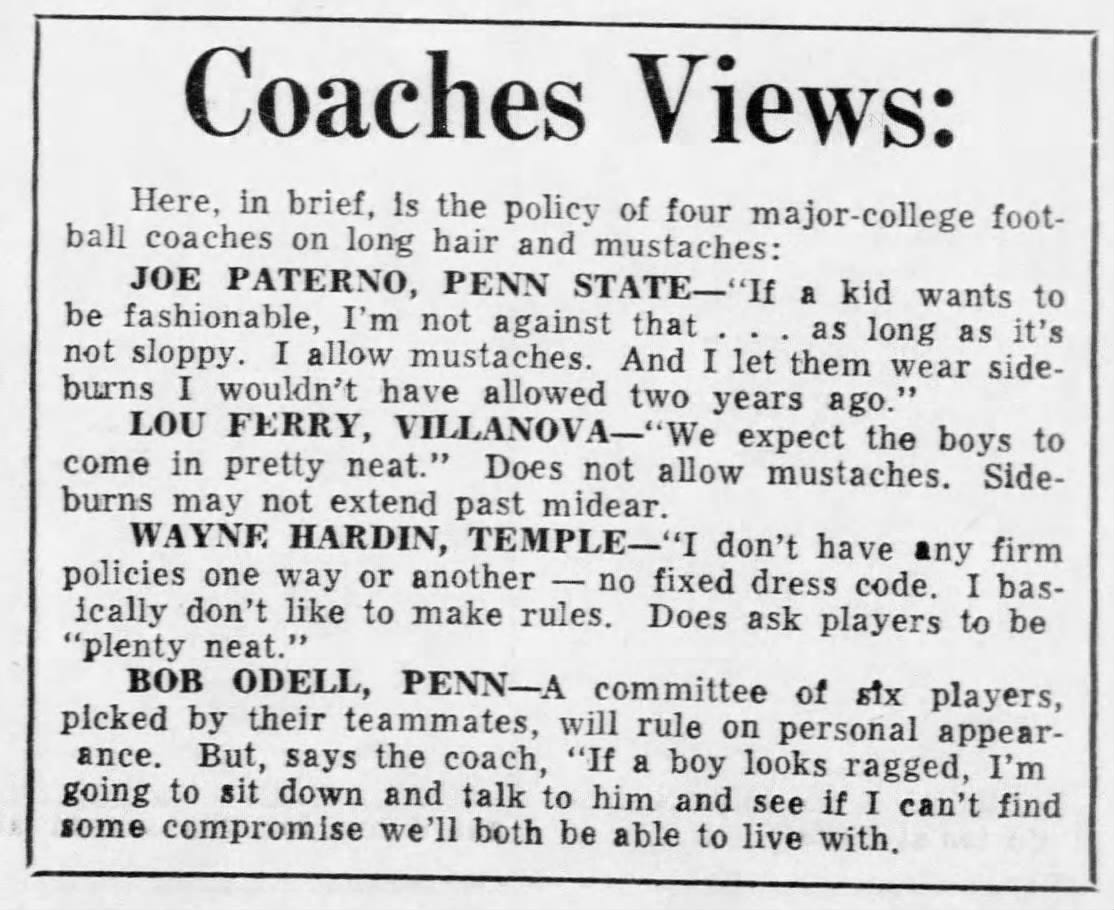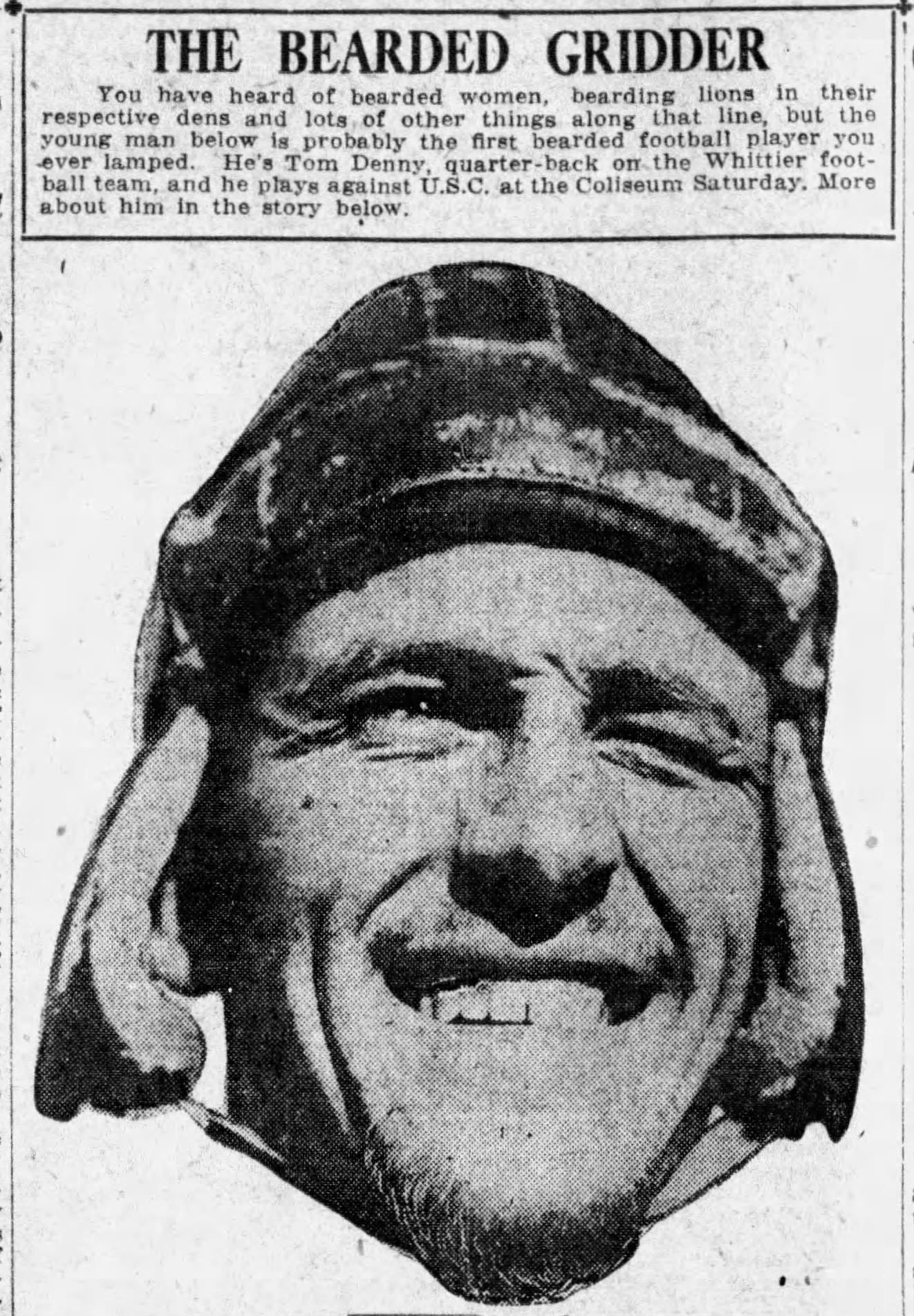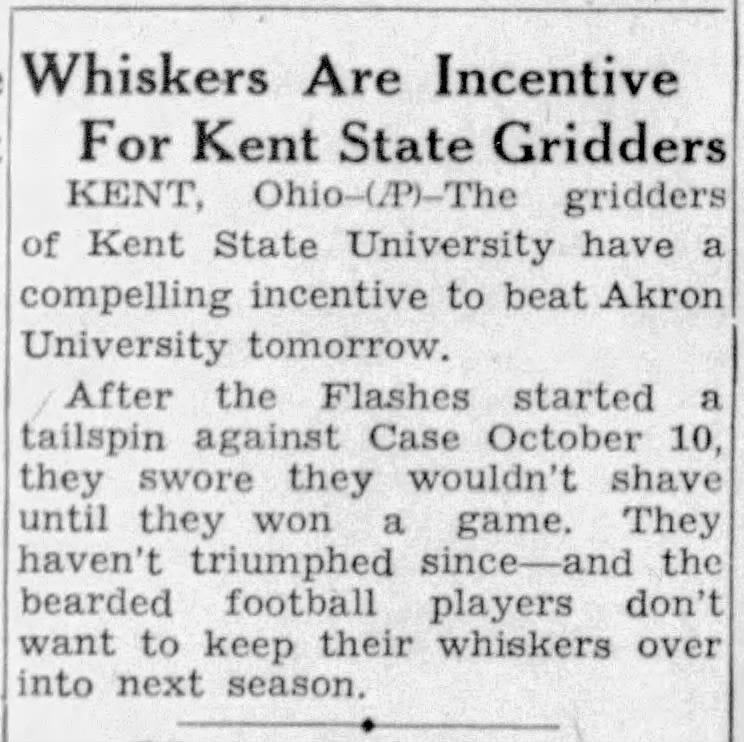Today's Tidbit... Football and Facial Hair
I've never cared much about facial hair or skinny jeans since my pull from the hereditary lottery provided limited facial hair and no skinny genes. Nevertheless, for the fourth time in my life, I am letting my facial hair grow out and will see if my friends and neighbors notice. They never have in the past.
Anyway, the stubble got me thinking about facial hair in the context of football. Beards and mustaches were popular in American society when football began, so facial hair was common among football players as well, with mustaches preferred over beards.
Football players also wore longer hair in the pre-helmet days to provide themselves with protection and warmth.
Somewhere along the line, the majority of college men became clean-shaven, so much so that bearded players were sufficiently rare that the occasional bearded player earned coverage in the newspapers.
Chin bristles were so unpopular that they became a form of self-punishment. Dave Bayliss, who played for the DC-area semi-pro team, lost a bet about who would win the 1932 election, so he had to remain unkempt until Christmas.
Position groups and entire teams got into the action when on losing streaks by vowing not to shave until they won a game. The 1931 CCNY team, the 1941 Kent State, and the 1955 Missouri teams all made such bets. Unfortunately for the Kent Staters, their next victory did not come until they topped Findlay by a close shave in October 1942.
Then came the 1960s and changes in styles stemming from the Beatles, the counterculture, and the Black Power movement, each associated with men wearing longer hair and facial hair. Football coaches who were fans of silly rules decided that real players wore team-issued chin straps, not the homegrown sort, so they mandated that team members keep their hair short and faces clean. Long hair and whiskers somehow represented all that was wrong with America's youth, so rules calling for their elimination became common.
The American Football League banned facial hair in 1966. To make some sort of point, New Mexico coach Rudy Feldman informed his 0-10 1968 team that everyone attending the football banquet must be clean-shaven, leading only half the team to show up. Even the defensive MVP opted out.
The same year, Dee Andros, Oregon State's head coach, ordered an athlete to shave per team rules, and the athlete's refusal led to him filing a complaint with the university's Commission on Human Rights and Responsibilities. The Commission found the coach in the wrong, though it allowed rules requiring neat facial hair in season, but it was anything goes out of season.
George Blackburn, Virginia's coach in 1970, issued team rules that banned smoking, drinking, cutting classes, excessive facial hair, and encouraged church attendance. The student council censured the coach and AD, and following a meeting, only his rules about physical training remained in effect.
Team rules regarding facial fuzz and hair length varied widely over the next decade or two before most realized a player's facial hair was no more important than their eye color in determining how well they performed on the gridiron.

Nevertheless, some, like Syracuse football coach Paul Pasqualoni, banned earrings, facial hair, and the wearing of hats in the football building in 2000, which undoubtedly helped his 6-5 team win games by a hair on occasion, right?
Now, football has come full circle. The bearded Walter Camp did not connect facial hair or hair length with football ability or character, and few coaches make the connection today.
Postscript
Per Stagg’s comment below about Herbert M. Burchard of the 1896 UChicago team, here’s his image, provided by Christoper Haack.
Football Archaeology is reader-supported. Click here to buy one of my books, donate, or otherwise support the site.








This is from Amos Alonzo Stagg's book, Touchdown: Our '98 team was distinguished for a number of things, the least of which was that it was Chicago's first wholly smooth-shaven squad. Burchard, at guard in 1896, a graduate student, fat and well beyond the normal college football age, had rubbed the dirt of many a field in a coal-black and bushy beard that would not have dishonored a Russian muzhik. Our last mustache bloomed in 1897. When Harvey Fox arrived on the squad that season, bringing with him a pair of burnsides, the tide had turned forever against such manly adornments. Failing to persuade Fox that his burnsides were a blot on an otherwise pleasant landscape, some of his mates enticed him one night to the home of his cousin, Henry Adkinson. As he entered the door, Harold L. Ickes, a Bull Moose leader in 1912, tackled him smartly, while Adkinson and one other leaped upon his shoulders. They trussed him up to an ironing board and shaved off the right burnside, Adkinson wielding the razor.
Great to see the name Bob Odell in the news clipping. Odell coached my hometown Bucknell Bison from 1958-64 where he twice won the small college Lambert Cup. Of personal note: Odell returned to Bucknell as a special assistant after his retirement from Williams, and was the guest speaker at my senior year football banquet in 1987 at Lewisburg H.S.